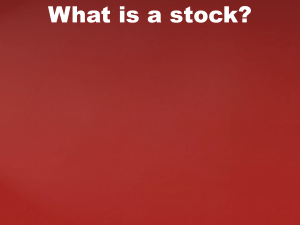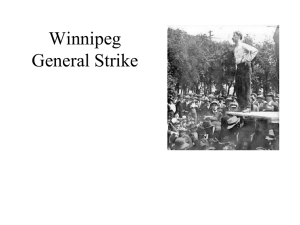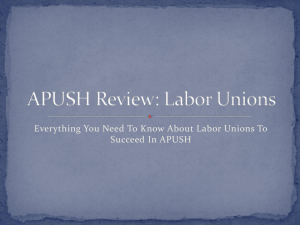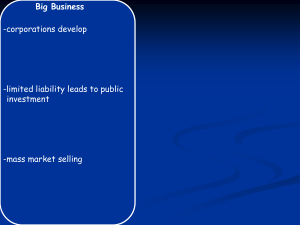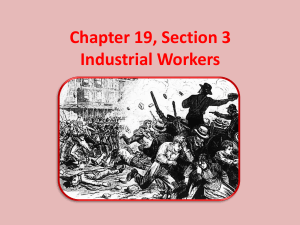Option
advertisement
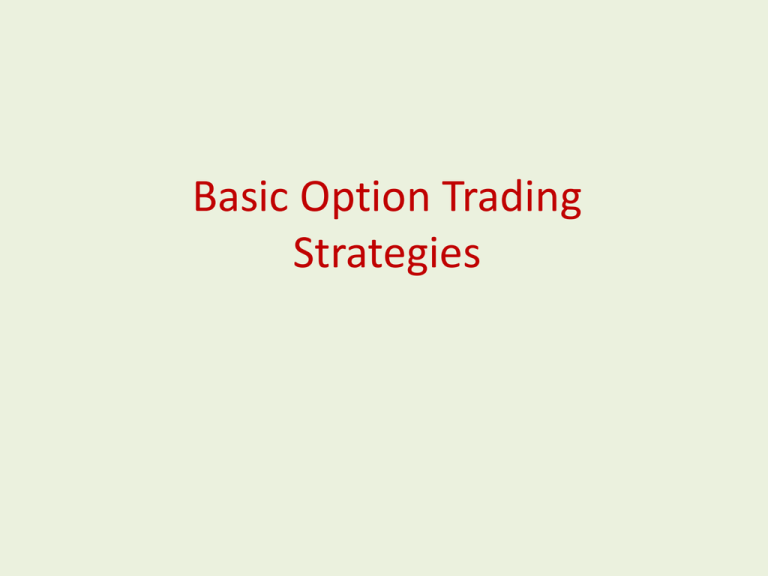
Basic Option Trading Strategies What is an option? Definition Option – an intangible right bought or sold by a trader to control 100 shares of a security; it expires on a specific date in the future. The option is a right to buy 100 shares, or to sell 100 shares. Every option has four specific features: 1. It relates to a specific stock or other security, called the “underlying” security.” 2. It is a right to buy (call) or sell (put), and every option controls 100 shares of stock. 3. A specific “strike” price is the fixed price at which the option can be exercised. 4. Every option has a fixed expiration date. After that date, the option is worthless. The standardized terms These four features – underlying security, type of option, strike price, and expiration date – are called “standardized terms.” They cannot be changed. Every option is unique in its combination of these terms. The underlying security An underlying security is the stock or other security on which the option is written. For example, an option on Caterpillar controls 100 shares of Caterpillar stock. This option cannot be transferred to a different underlying stock. It exists only on that one underlying. Type of option There are two types of options, calls and puts. A call grants its owner the right, but not the obligation, to buy 100 shares of stock. This right relates to a specific underlying security, at a fixed strike price, and expires on a specified date in the future. Options can be bought (a long position) or sold (a short position). When you sell an option, you grant the option right to the person on the other side of the trade. The strike price The option’s strike is the fixed amount per share at which the option can be exercised. “Exercise” means buying 100 shares (with a call) or selling 100 shares (with a put) at the fixed strike price. A call owner may exercise a call when the current market price is higher than the fixed strike. A put owner may exercise a put when the current market price is lower than the fixed strike. Expiration Every option expires on a specific date, called the “expiration date.” This is the third Saturday of the expiration month; the last trading day is the third Friday of expiration month. After expiration, every option that was not closed or exercised becomes worthless. Option trading There are dozens of option strategies. Those starting out in options trading are likely to restrict their activity to buying calls or puts and trying to profit on them. Option value increases when the underlying moves in the desired direction. Call buyers hope the underlying price rises, and put buyers hope it falls. Six basic strategies Six option strategies are especially interesting in the way they allow you to leverage capital, reduce risks, and control shares of stock. These six are: 1. Covered call. 2. Ratio write. 3. Variable ratio write. 4. Insurance put. 5. Collar. 6. Synthetic stock. Six basic strategies These strategies share a few common themes and attributes. These are: - They can be constructed with conservative goals in mind: reducing or eliminating risk and hedging long positions in your portfolio. - The positions either eliminate risk or generate income. - The level of capital placed at risk can be controlled by offsetting long and short positions, or limited by selecting modestly priced options. Covered call A covered call has two parts: - ownership of 100 shares of stock - 1 short call A “short” call is created by selling it. When you sell a call you receive cash. A short transaction is sequenced as “sell-hold-buy” instead of the more familiar long position, “buyhold-sell.” Covered call A covered call becomes profitable if the underlying security remains at or below the strike. In that case, the call will expire worthless, or it can be closed (bought) at a lower price. If the underlying security moves above the strike, the call will be exercised and your stock will be called away. Being exercised is profitable as long as your original cost of the stock was lower than the strike. In that case, you earn a capital gain, the option premium, and any dividends during your holding period. Ratio write The ratio write is an expansion of the covered call. Instead of 1 call per 100 shares, you write more calls than you can cover. For example, if you own 200 shares and sell 3 calls, you create a 3:2 ratio write. If you own 300 shares and sell 4 calls, you create a 4:3 ratio write. Although this strategy is higher-risk than a covered call, some or all of the exposed calls can be closed to avoid exercise. Variable ratio write This a further expansion of the covered call. In the variable ratio write, you use two different strikes. For example, the stock price is $49 and you own 300 shares. If you sell two $50 calls and two $52.50 calls, you have created a variable ratio write. Insurance put This strategy protects your stock position against the risk of loss. A put is the right to sell stock at a fixed price. For example, you bought stock at $45 and it is now worth $49. You sell a 50 put and pay 2 ($200). If the stock falls below 50, you can exercise the put and sell it at the fixed strike of 50. However, because the put cost you $200, your breakeven is $48 per share. In this example, the insurance put locks in profits of at least $300 – the strike less cost of the put, minus your original basis: $50 - $2 - $45 = $300 Collar A collar is a three-part strategy that combines the covered call with the insurance put. It consists of: 100 shares of stock 1 short call 1 long put Collar A collar costs little or nothing to open. The short call should be higher than the current price, and the long put should be lower. The cost of the long put is all or mostly paid for by the short put. The collar is a smart strategy when you want to protect paper profits, and you are willing to have shares called away at the call’s strike. Synthetic stock This is a strategy similar to the collar. But both options are opened at the same strike price. When you open a long call and a short put, it creates a synthetic long stock position, because the options grow in value as the stock rises, mirroring price changes point for point. When you open a short call and a long put, it creates a synthetic short stock position, because the options grow in value as the stock falls, mirroring price changes point for point. The market – an overview Options are very versatile trading devices. They can be very high-risk or very conservative. You can use calls or puts, or combinations of both. You can use long or short positions, or a combination of both. The market – an overview The problem with trading options is that a considerable learning curve is needed. This is mostly due to the special language of the options market. You need to master the language and the trading rules; and also to fully understand the potential risks of all positions you would enter. The market – an overview A common perception is that options are too complex for the typical trader. This is not true. The complexity is in that learning curve. Once you master that, it all becomes easier. A smart method for learning options is to paper trade and to investigate the market for yourself. The market – an overview Paper trading is a good way to start. This is a system for trading shares without using actual money. The best paper trading site is free, and is offered by the Chicago Board Options Exchange (CBOE). Link to them at : http://tinyurl.com/bv262mp The market – an overview Several sites also offer options education, and members can learn a lot about strategies and trading. I offer this through my site, ThomsettOptions.com – link to the site at http://tinyurl.com/cxqug78 Conclusion Options have grown since the market began in 1973. Today, billions of contracts are traded every year. Originally, options were mainly used by speculators and were very high-risk. Increasingly, options are used to reduce risks and create income in a portfolio. The options market has gone mainstream.

